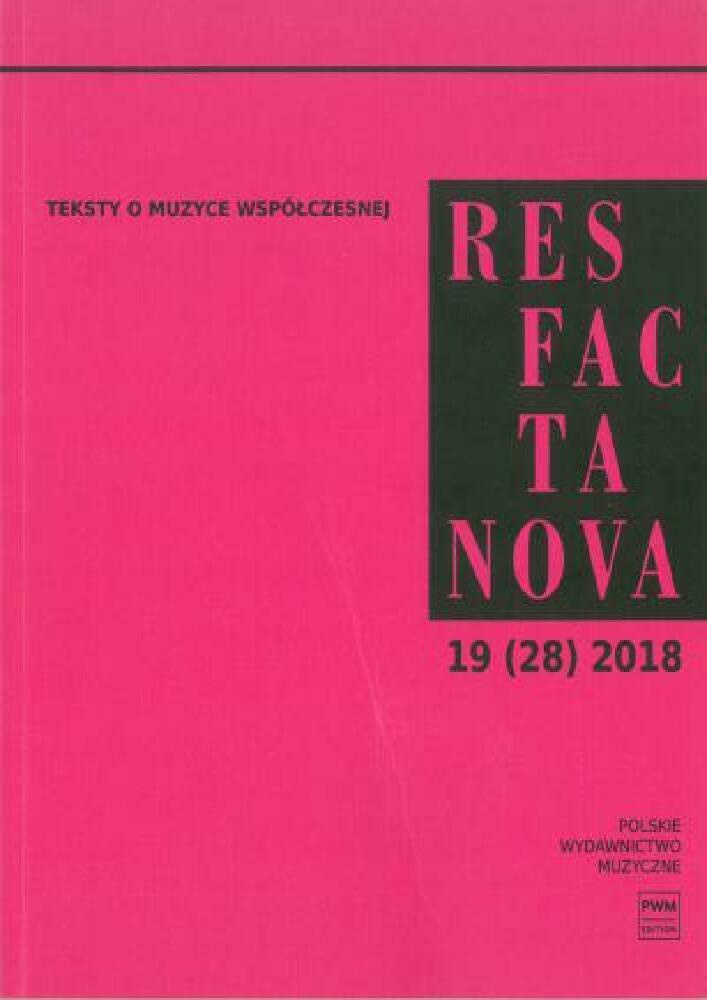Abstrakt
The subject of the analysis is the animated puppet film Aria by Pjotr Sapegin, which refers to the plot and the music – through the quotes from the aria ‘Un bel dì vedremo’ in the arrangement of Normand Roger – of the opera Madama Butterfly by Giacomo Puccini. By taking as a main reference point a description of musical operations made in the film and their contribution in constructing the meanings of the audiovisual work, the author of the article moves successively between several interpretation levels: historical (she situates the film within the puppet’s opera tradition), media-theoretical (she considers the qualitative transformation of the doll in theater and film in the perspective of different aesthetics of both media), theatrological (she reflects on the doll’s ontology, with particular emphasis on the question of comicality), and operological (she refers in part to the entire opera of Puccini and portrays more accurately verbal, musical and dramaturgical values of the aria ‘Un bel dì vedremo’, while proving that the Sapegin’s film is an example of meta-reflection on aria as a form of dramatic-musical expression). The multiple perspectives of the study are used to reveal the dramatic, stylistic, adaptive and philosophical complexity of Sapegin’s work and lead to the recognition of the capabilities of an animated film as an audiovisual medium that continually leads a creative dialogue with music as well as the potential of the puppet aesthetics at the beginning of the 21st century.
Bibliografia
Abramowska Janina, Serie tematyczne, w: eadem, Powtórzenia i wybory. Studia z tematologii i poetyki historycznej, Dom Wydawniczy „Rebis”, Poznań 1995, s. 34–52.
Augustyniak Monika, Aktorstwo lalki , „Teatr Lalek” 1990 nr 1 (29), s. 4–5.
Balázs Béla, Wybór pism , wybór i wstęp Aleksander Jackiewicz, przeł. Raoul Porges, Karol Jung, Filmowa Agencja Wydawnicza, Warszawa 1957.
Budden Julian, Puccini. His Life and Works, Oxford University Press, New York 2005.
Buschmeyer Lothar, Die Kunst des Puppenspiels, Oppelner Nachrichten Carl J. Pohl, Erfurt 1931.
Carteggi pucciniani, red. Eugenio Gara, Ricordi, Milano 1958.
Curtius Ernst R., Literatura europejska i łacińskie średniowiecze, przeł. i oprac. Andrzej Borowski, Universitas, Kraków 2009.
Cyceron Marek Tulliusz, O mówcy, przeł., wstępem i komentarzami opatrzył Bartosz Awianowicz, Wydawnictwo Marek Derewiecki, Kęty 2010.
Dahlhaus Carl, Dramaturgie der italienischen Oper, [w:] idem, Gesammelte Schriften in 10 Bänden, t. 2: Allgemeine Theorie der Musik II. Kritik – Musiktheorie/ Opern- und Librettotheorie – Musikwissenschaft, red. Hermann Danuser, współpraca: H.-J. Hinrichsen, T. Plebuch, oprac. B. Meischein, Laaber Verlag, Laaber 2001, s. 467–545.
Das ungarische Puppentheater heute, przeł. Johanna Till, red. Dezső Szilágyi, Corvina Verlag, Budapest 1978.
Dodds Eric R., Pogaństwo i chrześcijaństwo w epoce niepokoju. Niektóre aspekty doświadczenia religijnego od Marka Aureliusza do Konstantyna Wielkiego, przeł. Jacek Partyka, Wydawnictwo „Homini”, Wydawnictwo Benedyktynów „Tyniec”, Kraków 2014.
Eidam Klaus, Puppentheater und Autor. Referat auf der Konferenz der Puppenspieler und Autoren am 20./21. Mai 1959 in Karl-Marx-Stadt, Leipzig 1959.
Faulstich Werner, Medienästhetik und Mediengeschichte. Mit einer Fallstudie zu «The War of the Worlds» von G.H. Wells, Winter Verlag, Heidelberg 1982.
Figur und Spiel im Puppentheater der Welt, red. Publikationskommission der UNIMA pod kier. Dezső Szilágyi, współpraca: Ludwig Krafft i in., Henschelverlag Kunst und Gesellschaft, Berlin 1980.
Girardi Michele, Puccini. His International Art, przeł. Laura Basini, University of Chicago Press, Chicago 2000.
Greenwald Helen M., Picturing Cio-Cio-San: House, Screen, and Ceremony in Puccini’s „Madama Butterfly”, „Cambridge Opera Journal” 2000 t. 12 nr 3, s. 237–259.
Jurkowski Henryk, Czy koniec specyfiki? Estetyka teatru lalek w końcu wieku, „Teatr Lalek” 2000 nr 4 (63), s. 2–7.
Jurkowski Henryk, Dzieje teatru lalek. Od antyku do romantyzmu, Państwowy Instytut Wydawniczy, Warszawa 1970.
Jurkowski Henryk, Erotyka i teatr lalek, „Teatr Lalek” 1988 nr 1–2 (21–22), s. 2–9.
Kunze Stefan, Koncepcja dramatyczna a związek muzyki ze sceną w „Tannhäuserze” Richarda Wagnera, przeł. Krzysztof Kozłowski, [w:] Niemieckie studia nad muzyką i dramatem: antologia przekładów na język polski, wybór, oprac. i posłowie Anna Igielska, Katarzyna Lisiecka, wstęp Krzysztof Kozłowski, przekłady przejrz., popr. i oprac. Anna Igielska, Wydawnictwo Naukowe UAM, Poznań 2015, s. 155–175.
Łotman Jurij, Lalki w systemie kultury, przeł. Paweł Ustrzykowski, „Teatr Lalek” 1990 nr 1 (29), s. 2–3.
Makowiecki Andrzej Z., Lalka, Eros, seks, „Teatr Lalek” 1988 nr 1–2 (21–22), s. 15–17.
Nedbal Martin, Live Marionettes and Divas on the Strings: „Die Zauberflöte”’s Interactions with Puppet Theater, „The Opera Quarterly” 2012 t. 28 nr 1–2, s. 20–36.
Puccini Giacomo, Madama Butterfly (da John L Long e David Belasco), tragedia Giapponese di Luigi Illica e Giuseppe Giacosa, Milano 1920, <http://imslp.nl/imglnks/usimg/9/9b/IMSLP43383-PMLP07734-Puccini_-_Madama_Butterfly_-_Act_I_(full_score).pdf> (10.08.2017).
Ross Peter, Elaborazione leitmotivica e colore esotico in „Madama Butterfly”, [w:] Esotismo e colore locale nell’opera di Puccini: Atti del I Convegno internazionale sull’opera di Puccini a Torre del Lago, red. Jürgen Maehder, Giardini, Pisa 1985, s. 99–110.
Sandig Holger, Die Ausdrucksmöglichkeiten der Marionette und ihre dramaturgischen Konsequenzen, Salzer Reprographischer Betrieb, München 1958.
Sennett Richard, Upadek człowieka publicznego, przeł. Hanna Jankowska, Warszawskie Wydawnictwo Literackie „Muza”, Warszawa 2009.
Starewicz Władysław, Plastyka ożywiona, „Film na Świecie” 1984 nr 307–308, s. 27–28.
Wellins Mike, Myśleć animacją. Podręcznik dla filmowców, przeł. Andrzej Wojnach, Wydawnictwo Wojciech Marzec, Warszawa 2015.
Wolf Friedrich, Pupilla (Kasperltheater), „Die Neue Schaubühne” 1919 R. 1 z. 10, s. 312–314.

